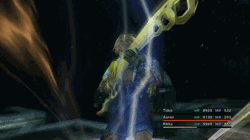 Final Fantasy 10 was a brilliant deconstruction of its franchise. And that statement is firmly past tense because it was immediately undercut by capitalism.
Final Fantasy 10 was a brilliant deconstruction of its franchise. And that statement is firmly past tense because it was immediately undercut by capitalism.
For the current moment, let us consider Kefka Palazzo. Kefka was ultimately the final antagonist of Final Fantasy 6, and he plainly stated his goal during his decisive battle: destroy everything, and build a monument to nonexistence. Colorful metaphor about modern art aside, Kefka had plans to kill the party, every other person alive, and (given enough time) obliterate the entire planet while he was at it. All that would be left would be a black void, and even Kefka himself seemed to nihilistically seek his own end if it meant everything else went with him.
And then the heroes of Final Fantasy 6 defeated Kefka. The madman crumbled to dust, and his evil plans were no more. Afterwards, there was approximately a half hour of credits and airship flying, Terra decided to feel the wind in her hair, and then…. Nothing.
Final Fantasy 6 ends with a The End logo, and the world stops existing. The next Final Fantasy starts on another world. Any heroes, townsfolk, or even moogles from Final Fantasy 6 are not seen in the franchise again. There may be “side stories” and alike, but these all seem to take place with versions of Terra, Kefka, and others from epochs before the end of Final Fantasy 6 (you can tell because Kefka is, ya know, alive). If the world of Final Fantasy 6 exists in any conceivable form after the fall of Kefka, there is no evidence of it across any official media.
Kefka wanted to destroy the world of Final Fantasy 6. Shortly after Kefka “failed”, the world of Final Fantasy 6 was forever destroyed, obliterated by an uncaring power button.
And, after this was the norm for nearly fifteen years and a solid nine Final Fantasy titles (and at least one spinoff), Final Fantasy 10 decided to definitively comment on this strange phenomenon.
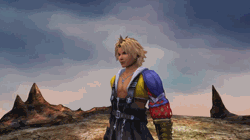 As is stated from literally the beginning, Final Fantasy 10 is the story of Tidus. And, since you are holding the controller that keeps that story going, you are meant to be Tidus, too. Tidus is good at playing games in a technologically advanced world, but his life is turned upside down when a tragedy transports him to Spira. Spira is a much more rural, primitive spot, and something very foreign to our “modern” Tidus. Ultimately, everything you see of this world exactly matches to the time Tidus spends in this strange place. You experience every second of his journey there, and you know exactly what you know of Spira exclusively through his eyes and what he learns from others. Tidus only discovers new things about Spira if you choose to talk to more people or see more places in Spira. And even though Tidus has his own issues to work through, you wholly inhabit his view of this alien world, complete with leaving Spira exactly when he exits. You are a strange visitor from an advanced (and implied to be more enlightened/less superstitious) society, here to save the world with ideas that could only belong to an outsider. When your job is completed, everyone is going to miss you to the point of tears, but despite their protests, you literally disappear.
As is stated from literally the beginning, Final Fantasy 10 is the story of Tidus. And, since you are holding the controller that keeps that story going, you are meant to be Tidus, too. Tidus is good at playing games in a technologically advanced world, but his life is turned upside down when a tragedy transports him to Spira. Spira is a much more rural, primitive spot, and something very foreign to our “modern” Tidus. Ultimately, everything you see of this world exactly matches to the time Tidus spends in this strange place. You experience every second of his journey there, and you know exactly what you know of Spira exclusively through his eyes and what he learns from others. Tidus only discovers new things about Spira if you choose to talk to more people or see more places in Spira. And even though Tidus has his own issues to work through, you wholly inhabit his view of this alien world, complete with leaving Spira exactly when he exits. You are a strange visitor from an advanced (and implied to be more enlightened/less superstitious) society, here to save the world with ideas that could only belong to an outsider. When your job is completed, everyone is going to miss you to the point of tears, but despite their protests, you literally disappear.
Hey, there is probably a reason the only characters you get to personally name in Final Fantasy 10 are Tidus and the aeons, the super-powered agents of Tidus’s “other” world. These characters are yours. Everyone else you are just visiting.
And this ties neatly into Final Fantasy 10’s concept of finality.
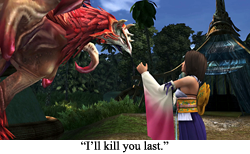 Magical memory whammies or whatever is happening aside, Tidus apparently comes from a world where the afterlife is an unknowable mystery. But Spira has a concrete answer to this age-old question: if you die with regrets, you are likely to either become a fiend, or live on as some manner of ageless zombie. A summoner may “send” the dead to the Farplane (a magical but firmly visitable place), but if some undead avoid this fate, they will stick around for literally eternity and continue to make a mess of things. At best, the living dead of Spira are perpetuating endless spirals of destruction, and at worst they are literally monsters. So, in short, a huge theme of Final Fantasy 10 is “don’t wear out your welcome”. You died, get over it, move on. If you stick around, you are going to hurt everybody still alive.
Magical memory whammies or whatever is happening aside, Tidus apparently comes from a world where the afterlife is an unknowable mystery. But Spira has a concrete answer to this age-old question: if you die with regrets, you are likely to either become a fiend, or live on as some manner of ageless zombie. A summoner may “send” the dead to the Farplane (a magical but firmly visitable place), but if some undead avoid this fate, they will stick around for literally eternity and continue to make a mess of things. At best, the living dead of Spira are perpetuating endless spirals of destruction, and at worst they are literally monsters. So, in short, a huge theme of Final Fantasy 10 is “don’t wear out your welcome”. You died, get over it, move on. If you stick around, you are going to hurt everybody still alive.
Thus, the true “end” for Spira’s story is when the party reaches the end of the pilgrimage, and Yuna and the rest of the party decide they are not going to feed the cycle anymore by rejecting Yunalesca, the jackass who got this ball of rubbish rolling. This makes slaying Sin a sort of coda, as the “important” ending has already happened. Change is now an inevitability. And this is further reinforced by Seymour, who had been a threatening antagonist throughout much of the quest, but now only represents the old world and old problems. Once he is deprived of his “immortal” cycle, he is little more than a speed bump. Beating a man you killed two times already is just as insignificant as that task should be. Similarly, the technical final battle isn’t the big damn boss fight of Braska’s Final Aeon, but a slow, aggravating slog through killing your Aeons. And that sucks! That whole sequence sucks, and “you just beat the Elite 4, now kill all your Pokémon” is as terrible as that sounds. But it is there. It is the last time you control this party, and it is miserable. And that is the whole, deliberate point: you are not supposed to keep being Yuna’s Pilgrimage Party. That is over now, and making it go on any longer will just bring heartache. Time to go, Tidus, your dream, your story is over. Time to hit that power button, player, the game is over now, too.
You have to leave this world behind. All of Spira, all of Final Fantasy 10 will end now and be gone forever, but you will live on. This adventure is over, but you will be better for it.
 And this would have been the ideal moral for a Final Fantasy title that matched every Final Fantasy that came before 2001. Sure, Seymour, Kefka, Sephiroth, and every villain that wanted to destroy their world had technically won by virtue of dying and leaving behind a world no longer requiring a player to defend it, but outside of the meta-narrative of the player living on, these were games with happy endings. Yuna, Terra, and Cloud would live to see a happily ever after, and we were left with only our imaginations to guess what happened to these heroes after we left them alone. Did Terra truly find love in her new family? Did Cloud and Tifa decide to settle down? Did Yuna become a pop idol cross treasure hunter?
And this would have been the ideal moral for a Final Fantasy title that matched every Final Fantasy that came before 2001. Sure, Seymour, Kefka, Sephiroth, and every villain that wanted to destroy their world had technically won by virtue of dying and leaving behind a world no longer requiring a player to defend it, but outside of the meta-narrative of the player living on, these were games with happy endings. Yuna, Terra, and Cloud would live to see a happily ever after, and we were left with only our imaginations to guess what happened to these heroes after we left them alone. Did Terra truly find love in her new family? Did Cloud and Tifa decide to settle down? Did Yuna become a pop idol cross treasure hunter?
Oh yeah, we definitely know the answer to a few of those questions now…
Final Fantasy 10 was the first Final Fantasy to truly embrace the concept of being “final”. It was also the Final Fantasy released closest to Kingdom Hearts, a franchise that immediately revived the likes of Tidus, Wakka, and eventually even Auron (who is six kinds of dead before the game even started!). Final Fantasy 10-2 was teased as part of a trailer tacked onto the finale of FFX’s American release, and the Eternal Calm gave way to a game that all but obliterated any sort of finality in Final Fantasy 10. Shortly thereafter, every Final Fantasy retroactively jumped onto Dissidia and alike to be similarly eternal. Final Fantasy 10 started the trend, but by the time we could buy cell phone games featuring the offspring of the Final Fantasy 4 cast plowing through the same stupid dungeons over and over again, the message had become clear: there would never be an end to any Final Fantasy adventure ever again.
And, in much the same way Final Fantasy 10 asked us to accept that death is the natural end of all things, we must now accept that eternal life is the natural state of all brands.
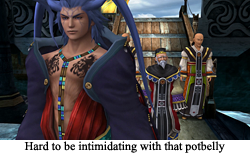 There will never not be new Final Fantasy 10 media for the rest of our lives. Any given “HD rerelease” of FF10 will inevitably stoke the rumors of a Final Fantasy 10-3, and we may eventually see such a product “because the fans demand it”. In the meanwhile, Tidus will appear in any game that requires Final Fantasy cameos, and any of those “cameos” could be excuses to foist new pathos or backstory on our intrepid Blitzball player (depending on how serious anyone wants to be about a game where a clown can fight a tree). In 2001, it was reasonable to assume that Tidus’s story was one-and-done, and we would never see anything further to elucidate his limited life beyond the odd Ultimania release. Now? Now our grandkids are going to be learning that the third lizard that Tidus curb-stomped was secretly the fiend-reincarnation of the dude that founded the Yevon chapter of the Boy Scouts, and further information will be available on a cell phone-based lottery game released to promote Final Fantasy 19.
There will never not be new Final Fantasy 10 media for the rest of our lives. Any given “HD rerelease” of FF10 will inevitably stoke the rumors of a Final Fantasy 10-3, and we may eventually see such a product “because the fans demand it”. In the meanwhile, Tidus will appear in any game that requires Final Fantasy cameos, and any of those “cameos” could be excuses to foist new pathos or backstory on our intrepid Blitzball player (depending on how serious anyone wants to be about a game where a clown can fight a tree). In 2001, it was reasonable to assume that Tidus’s story was one-and-done, and we would never see anything further to elucidate his limited life beyond the odd Ultimania release. Now? Now our grandkids are going to be learning that the third lizard that Tidus curb-stomped was secretly the fiend-reincarnation of the dude that founded the Yevon chapter of the Boy Scouts, and further information will be available on a cell phone-based lottery game released to promote Final Fantasy 19.
Final Fantasy 10 told a tale letting go, but it was released exactly when Squaresoft (soon to be Square Enix) needed to recoup some losses. It was released exactly when it was discovered you couldn’t just repurpose your Final Fantasy 5 sprites to be Final Fantasy 6 sprites in the high-definition(ish) world of next gen consoles. It was released exactly when the luxurious days of the Playstation were ending, and Grand Theft Auto 3 was about to be the hot new genre of choice. Final Fantasy 10 had the audacity to speak of finality when Squaresoft would never be able to make anything “final” ever again. In Final Fantasy’s near future, even apparent bombs like World of Final Fantasy would have to put in their time in the Meli-Melo gacha mines!
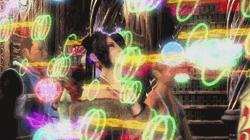 And is that all bad? Well, truth be told, if I had the choice between Final Fantasy 10 having a more focused message, or being able to play Final Fantasy 10-2, I’d choose Final Fantasy 10-2 every time. Morals and lessons are all well and good, but Wakka can come out of Blitzball retirement anytime Square wants, because there is at least a 30% chance a game including him will be good (just so long as no one actually plays Blitzball). Finality in a videogame may be impossible for Square Enix nowadays, but the world doesn’t really need videogames to be final. We like videogames, SE, so feel free to keep churnin’ ‘em out.
And is that all bad? Well, truth be told, if I had the choice between Final Fantasy 10 having a more focused message, or being able to play Final Fantasy 10-2, I’d choose Final Fantasy 10-2 every time. Morals and lessons are all well and good, but Wakka can come out of Blitzball retirement anytime Square wants, because there is at least a 30% chance a game including him will be good (just so long as no one actually plays Blitzball). Finality in a videogame may be impossible for Square Enix nowadays, but the world doesn’t really need videogames to be final. We like videogames, SE, so feel free to keep churnin’ ‘em out.
But it does mean Final Fantasy 10’s message is forever marred by its masters. Playing Final Fantasy 10, and then immediately segueing to its sequel is not only now possible, but seemingly encouraged by releases that pair it with Final Fantasy 10-2 (and 10-2’s “six months later” teaser). Final Fantasy 10 was a game all about finales, but now it will never see its own finale.
Final Fantasy 10 wants you to learn to let go. Square Enix missed that lesson.
FGC #647 Final Fantasy 10
- System: Playstation 2, Playstation 3, Playstation 4, Playstation 5. Probably an Xbox here or there. Gotta be a Nintendo Switch available, too. Oh, and the Steam/PC version apparently has time saving toggles for boosting exp and alike. Why isn’t that available on a console again?
- Number of players: This is Tidus’s story. So one.
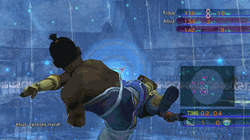 Level Up: After years of leveling systems in Final Fantasy titles trying unique things like Esper customization or learning skills from armor, Final Fantasy 10 finally eschewed the whole concept of traditional leveling and brought us the Sphere Grid. And it’s good! I like it! Unfortunately, it kicked off a wave of sphere grid-alikes in every JRPG from here to NIS, and… maybe not every videogame needs a complicated leveling system barring entry to just jumping in and enjoying slaying monsters. If I need a strategy guide to determine whether or not I am screwing up my “build” from the first minute…
Level Up: After years of leveling systems in Final Fantasy titles trying unique things like Esper customization or learning skills from armor, Final Fantasy 10 finally eschewed the whole concept of traditional leveling and brought us the Sphere Grid. And it’s good! I like it! Unfortunately, it kicked off a wave of sphere grid-alikes in every JRPG from here to NIS, and… maybe not every videogame needs a complicated leveling system barring entry to just jumping in and enjoying slaying monsters. If I need a strategy guide to determine whether or not I am screwing up my “build” from the first minute…- Play Ball: I do not care for Blitzball. But, hey, I was never a big fan of Triple Triad in its time, either. Maybe one day I will find joy in math-ball.
- Favorite Summon: Anima. Geez, Anima. You are the living (kinda) encapsulation of everything wrong with the beliefs of Yevon, a creature harnessing unending pain to punish monsters, and you have a cool, freaky venus-fly-trap-mummy thing going on. And you punch a lot! Here’s to you, Anima!
- Videogame Fayth: The puzzle rooms in every religious temple in Final Fantasy 10 really raise some questions. Are the cloisters of trials exclusively there for summoners, or does the cleaning staff have to juggle a series of magical orbs every time they need to dust Bahamut’s remains? And is your average Yevon priest solving block puzzles as part of their seminary?
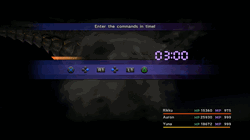 Goggle Bob Fact: I have always considered myself fairly… Woke? My parents are liberal and raised me in a fairly progressive fashion, but I… kind of didn’t notice Wakka when I first played Final Fantasy 10 back during my freshman year of college. But now when I play the game? Holy crap is he racist! It is fantasy racism, but the fact that he is a religious zealot that takes every spare moment he can find to denigrate the Al Bhed is exceptionally concerning. And I did not observe it at all twenty years ago! I guess I wasn’t as “woke” as I thought back then. Maybe I still have more to learn now…
Goggle Bob Fact: I have always considered myself fairly… Woke? My parents are liberal and raised me in a fairly progressive fashion, but I… kind of didn’t notice Wakka when I first played Final Fantasy 10 back during my freshman year of college. But now when I play the game? Holy crap is he racist! It is fantasy racism, but the fact that he is a religious zealot that takes every spare moment he can find to denigrate the Al Bhed is exceptionally concerning. And I did not observe it at all twenty years ago! I guess I wasn’t as “woke” as I thought back then. Maybe I still have more to learn now…- Did you know? Final Fantasy 10 was released in America on December 17, 2001. I think ROB tried to aim their randomness at this date. I am starting to suspect something is up with that robot.
- Would I play again: Assuming I have hours and hours to kill, I would like to play Final Fantasy 10 again. That said, it might be another decade before I get back to number ten.
What’s next? Random ROB has chosen to take a few weeks off, as it is holiday time! Let’s aim for our annual winter celebration post next week! Please look forward to it!
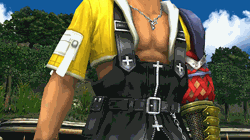
We’ll laugh about this later
[…] your dough on a separate upgrade tree to enjoy that (though, if you want, you can play with its sphere grid). Even improving the colonies feels a thousand times better than it did in previous […]
[…] skill upgrades, or a magical ability to sleep longer? It would all be part of some wannabe sphere grid, and you’d be pumping Bincho Points (BP) into the branch you would like to see upgraded. It would […]
[…] moments are a lot more subtle than what we see in contemporaneous RPGs (let me tell you about Auron. Or, let him tell you about it for […]
[…] would be hard to lose the final-final fight of Xenogears. This contrasts with Final Fantasy 10, where you can find some exciting ways to commit […]
[…] please enjoy us attempting to “sing” Final Fantasy 10’s […]